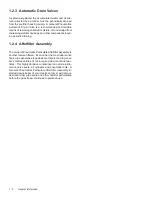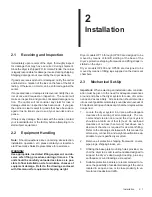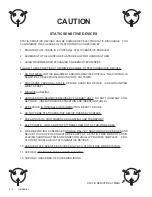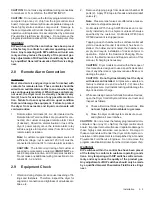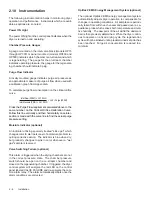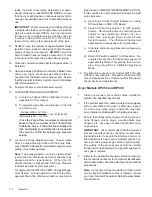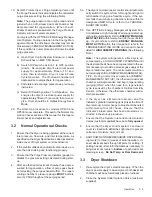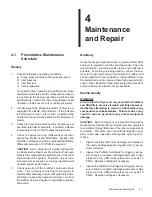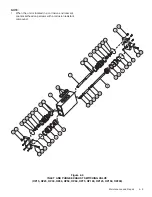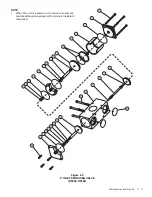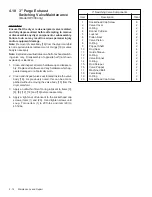
4 - 2
Maintenance and Repair
Annually
WARNING!
Ensure that the Dryer and any associated Prefilters
and Afterfilters are valve isolated and fully depressur-
ized before attempting to remove or disassemble any
components or subassemblies. Failure to do so may
result in serious personal injury and/or equipment
damage.
1.
Disassemble, clean and inspect the Outlet and Purge
Check Valve Assemblies. Replace all damaged or
worn parts.
2.
Disassemble, clean and inspect the Inlet Switching
and Purge Exhaust Switching Valves. Replace all
damaged or worn parts.
3.
Remove the desiccant fill port plugs or drain port
flanges from the top of each desiccant chamber. Vi-
sually inspect the desiccant through each chamber’s
fill port. Replace desiccant if it appears badly broken
or contaminated with oil.
4.2
Desiccant Charging
Procedures
Note: Periodic desiccant replacement is necessary to
maintain dryer performance. The frequency of desiccant
replacement is dependent on the actual operating condi-
tions present, and will vary in all cases. These conditions
can be process related, mechanical or accidental. A rising
dew point at the dryer outlet is an indication that new des-
iccant is required. This is assuming that the dryer is func-
tioning properly from a mechanical and control
standpoint; and the dryer is not being overloaded (oper-
ated above its maximum flow capacity).
Desiccant is normally installed prior to shipment unless
otherwise specified by the customer. Tapping on each
desiccant chamber with a soft-face mallet will yield a dead-
ened sound if desiccant has been installed. If a hollow
sound is noted, the chambers are empty and require instal-
lation of desiccant before operation.
WARNING!
Ensure that the Dryer is de-energized, valve isolated
and fully depressurized before attempting to remove
or disassemble any Dryer component or subassembly.
Failure to do so may result in serious personal injury
and/or equipment damage.
CAUTION: Dryer models covered within the scope of this
manual are designed to use a specific desiccant. Use of
any other size or type may reduce efficiency or damage the
Dryer.
CAUTION: Prior to installing desiccant, review all appli-
cable Material Safety Data Sheets and container warnings.
Safety Data Sheets may be obtained from the manufactur-
ers Safety Coordinator. Exercise all necessary precau-
tions for your health and welfare.
WARNING!
A static electric charge can build up when pouring
desiccants or dry powders. Proper grounding should
be observed when pouring from a container (bag,
drum, etc.).
WARNING!
Do not transfer desiccant under pressure. Malfunction
or improper use of equipment can propel beads with
enough velocity to penetrate skin.
WARNING!
Used desiccant material must be handled with special
care. Desiccant is an adsorbent material. Used desic-
cant may contain chemicals and/or gases that are haz-
ardous, toxic and/or flammable. It is recommended
that all used desiccant be analyzed to determine con-
tent before disposal. Exercise proper care and proce-
dures during handling and storage of used materials.
All containers must be properly labelled and disposed
of in accordance with Local, State and Federal regula-
tions.
1.
Remove the desiccant fill port plug or drain port
flange installed in the top of each desiccant chamber.
Clean and inspect the fill port closure.
Note: If this is an Initial Desiccant Installation Proce-
dure go to Procedure 8.
2.
Place a container suitable for receiving the spent des-
iccant under the desiccant chambers.
3.
Remove desiccant drain port plug or drain port flange
from the bottom of each desiccant chamber. When
the drain port plug or drain port flange is removed, the
desiccant will begin draining.
4.
Use a flashlight to inspect each chamber through its
respective fill port to ensure that all desiccant has
been drained. LIGHT tapping on the chamber sides
with a soft-face mallet will remove any desiccant that
may have remained in each chamber.
5.
Use a wire brush to clean drain ports and drain port
plug threads.
6.
Apply TFE tape to drain port plug threads. Reinstall
drain port plugs or drain port flanges into each drain
port. Torque drain port plugs or flange bolts to a rea-
sonable limit.
7.
Refer to Table 4.1 for the quantity of desiccant and
tabular support required for each desiccant chamber.
8.
Utilizing an appropriately sized funnel, fill each desic-
cant chamber as follows:

